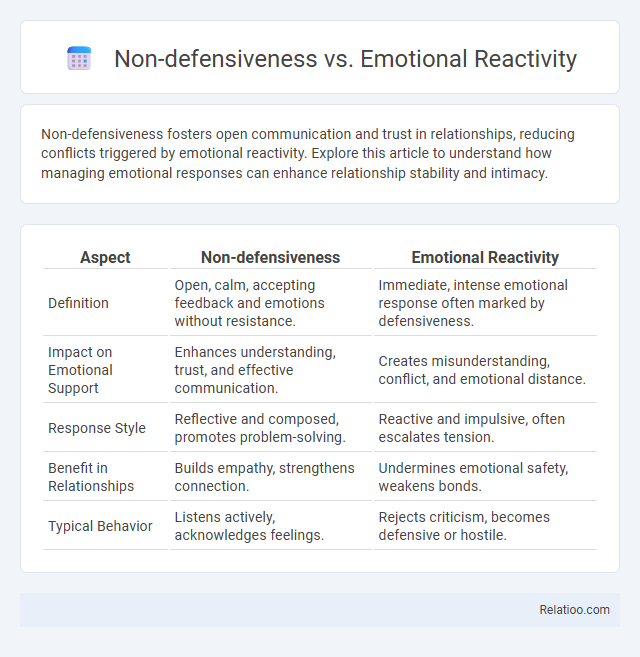Non-defensiveness fosters open communication and trust in relationships, reducing conflicts triggered by emotional reactivity. Explore this article to understand how managing emotional responses can enhance relationship stability and intimacy.
Table of Comparison
| Aspect | Non-defensiveness | Emotional Reactivity |
|---|---|---|
| Definition | Open, calm, accepting feedback and emotions without resistance. | Immediate, intense emotional response often marked by defensiveness. |
| Impact on Emotional Support | Enhances understanding, trust, and effective communication. | Creates misunderstanding, conflict, and emotional distance. |
| Response Style | Reflective and composed, promotes problem-solving. | Reactive and impulsive, often escalates tension. |
| Benefit in Relationships | Builds empathy, strengthens connection. | Undermines emotional safety, weakens bonds. |
| Typical Behavior | Listens actively, acknowledges feelings. | Rejects criticism, becomes defensive or hostile. |
Understanding Non-Defensiveness and Emotional Reactivity
Understanding non-defensiveness involves recognizing a calm, open stance in conversations, allowing for constructive feedback without personalizing criticism. Emotional reactivity, by contrast, triggers immediate, intense emotional responses that cloud judgment and hinder effective communication. Cultivating non-defensiveness enhances emotional regulation and fosters healthier interpersonal relationships by minimizing conflict and promoting empathy.
The Psychology Behind Defensive Behavior
Defensive behavior often stems from a perceived threat to Your self-esteem or identity, triggering emotional reactivity as a protective mechanism. Non-defensiveness involves maintaining emotional regulation and openness, allowing effective communication without impulsive reactions. Understanding the psychology behind these responses reveals how non-defensiveness can foster resilience by reducing emotional reactivity and promoting constructive interactions.
Signs of Emotional Reactivity in Communication
Signs of emotional reactivity in communication include rapid, intense emotional responses such as anger or frustration that override rational thinking and escalate conflicts. These responses often manifest as interruptions, raised voices, or defensive body language, signaling an inability to regulate emotions effectively. Recognizing these signs helps differentiate emotional reactivity from non-defensiveness, where individuals respond calmly and openly without emotional escalation.
Benefits of Practicing Non-Defensiveness
Practicing non-defensiveness enhances your emotional intelligence by allowing you to respond calmly rather than reacting impulsively, leading to more productive and respectful communication. It reduces conflict and strengthens relationships by promoting understanding and empathy instead of escalation driven by emotional reactivity or defensiveness. Embracing non-defensiveness fosters personal growth, resilience, and a clearer perspective in challenging situations.
Triggers That Fuel Emotional Reactivity
Triggers that fuel emotional reactivity include perceived threats, criticism, and unresolved past traumas, which activate the amygdala's fight-or-flight response. Non-defensiveness involves recognizing these triggers without immediate judgment or retaliation, enabling a calm and measured reaction. Cultivating non-defensiveness helps reduce emotional reactivity by fostering self-awareness and emotional regulation techniques that disrupt automatic defensive impulses.
How Non-Defensiveness Enhances Relationships
Non-defensiveness enhances relationships by fostering open communication and trust, allowing individuals to listen empathetically without immediately reacting to perceived criticism. This approach reduces emotional reactivity, which often escalates conflicts and damages connections, by promoting calm, thoughtful responses. Embracing non-defensiveness creates a supportive environment where vulnerability is accepted, strengthening emotional bonds and mutual understanding.
Techniques for Reducing Emotional Reactivity
Techniques for reducing emotional reactivity include practicing mindfulness meditation, which enhances self-awareness and reduces impulsive responses to triggers. Cognitive-behavioral strategies such as reframing negative thoughts help manage emotional intensity by promoting rational thinking. Developing emotional regulation skills through deep breathing exercises and progressive muscle relaxation also supports non-defensiveness by preventing escalation during conflicts.
Building Emotional Resilience Over Defensiveness
Building emotional resilience over defensiveness involves recognizing your emotional triggers and responding thoughtfully rather than reactively. Emotional reactivity often leads to impulsive responses that hinder communication, while non-defensiveness allows you to engage openly, fostering understanding and growth. Strengthening emotional resilience empowers you to maintain composure, manage stress, and enhance interpersonal relationships effectively.
Common Myths About Non-Defensiveness
Common myths about non-defensiveness include the misconception that it means suppressing emotions or passively accepting criticism without response. True non-defensiveness involves maintaining emotional regulation and openness, fostering constructive dialogue rather than emotional reactivity or avoidance. Understanding that non-defensiveness enhances communication and conflict resolution helps debunk the false equivalence with emotional passivity or weakness.
Practical Steps to Cultivate Non-Defensive Responses
Cultivating non-defensive responses requires conscious awareness of emotional triggers and practicing mindfulness to pause before reacting. Techniques such as deep breathing, reflective listening, and reframing negative thoughts help reduce emotional reactivity and foster calm communication. Consistent self-reflection and seeking feedback contribute to building resilience and strengthening non-defensive interactions in both personal and professional relationships.

Infographic: Non-defensiveness vs Emotional Reactivity
 relatioo.com
relatioo.com